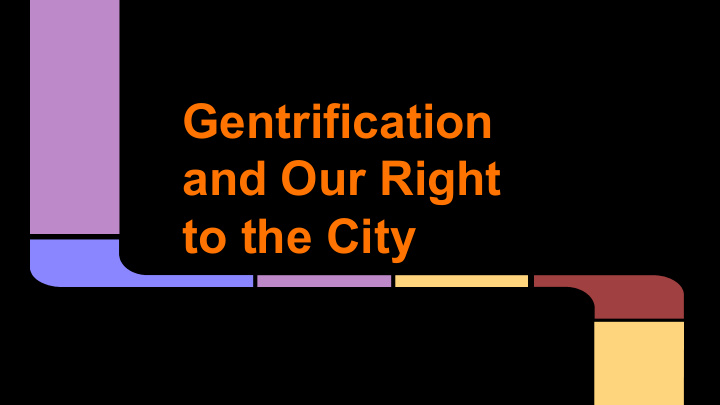



Gentrification and Our Right to the City
Course Roadmap 1. Key Concepts and Debates 2. Situating Gentrification Globally and Nationally 3. Break! 4. Case Studies from San Antonio 5. The Right to the City Framework 6. Dialogue
Definitions from Urban Sociology ● “The transformation of a working class or vacant area of the central city into middle class and/or commercial use” ● Short and sweet: “class-based displacement” (Lees, Slater, and Wyly 2008)
Definition from Grassroots Organizing “We define gentrification as a profit-driven racial and class reconfiguration of urban, working-class, and communities of color that have suffered from a history of disinvestment and abandonment. The process is characterized by declines in the number of low-income people of color in neighborhoods that begin to cater to higher-income workers willing to pay higher rents. Gentrification is driven by private developers, landlords, businesses, and corporations, and supported by the government through policies that facilitate the process of process of displacement, often in the form of public subsidies. Gentrification happens in areas where commercial and residential land is cheap, relative to other areas of the city and region, and where the potential to turn a profit either through repurposing existing structures or building new ones is great.” (Causa Justa, Development without Displacement, 2014)
Classical Gentrification ● Defined by Ruth Glass, London 1964 ● Individual rehab of inner city fixer uppers ● In US, more racialized: “reverse white flight” ● Began NYC in 1970s ● Uneven process nationally
Contemporary Gentrification ● Individual rehabs-->prominence of developers and real estate interests ● “New build gentrification” ● Rural gentrification ● A “global urban strategy” (Lees et al) ● Planning platitudes: the “creative class” (Florida), “smart growth” (Speck)
Key Tensions and Debates ● Is gentrification actually happening, or is it just reurbanization? ● Is displacement actually happening, or is it just replacement? ● Is gentrification a top-down or bottom-up process? ● What about “gentefication”?
Features of Capitalism ● Commodification (“thingification”) of labor and nature ● Private ownership of the means of production (factories, farms, tools, machines, land) ● Wage labor for everyone else ● Class society (inherent inequality between owners and workers) ● Profit motive/logic (grow or die)-->fatal contradictions (boom and bust, ecological) ● David Harvey on the banking crisis: http://www.youtube.com/watch?v=qOP2V_np2c0
Stages of Capitalism: Competitive ● 19th c ● “robber baron” capitalism ● violent clashes between bosses and workers
Stages of Capitalism: Monopoly/Industrial ● 20th c ● Centralized corporate power ● Big companies/ big govt/big labor ● Fordism
Stages of Capitalism: “New” (Global, Flexible, Post-Industrial) ● late 20th & 21st ● highly mobile (“flexible”) ● decentralized corporate power ● outsourcing ● deindustrialization ● permatemping
Neoliberalism ● new relationship between state and capital ● 1970s-present ● austerity politics and privatization ● state deregulation and transnational corporations ● less corporate accountability to local impacts
Neoliberal Urbanism ● austerity politics on the local level ● cities as points of federal distributions-- >cities as little businesses competing for private investment ● public-private partnerships ● “growth machines” (Logan and Molotch) ● the “seventeen white men” (Berriozabal)
The National Context: Urban Removals ● race-based displacement as “primary accumulation” (genocide, slavery) ● “two tier housing policy” (Hayden) ● urban renewal programs, 1960s-1980s
The “Decade of Downtown”
Impacts of Downtown Redevelopment: Privatization of Public Space Hays Street Bridge Restoration Group vs City of San Antonio
Impacts of Downtown Redevelopment: Erasure of POC/Working Class Histories Arrest of “Univision 8” to protest demolition of first Spanish language TV station in US
Impacts of Downtown Redevelopment: Forced Removal/Displacement Mission Trails residents file lawsuit against American Family Communities
Resident Testimonio Mary Flores and others: http://bit.ly/1u1HOHm “People’s Luncheon on Real Solutions to Gentrification”: http://bit.ly/1vpaPIk
The Right to the City Framework ● Conceptual framework and global movement ● Henri Lefebvre, 1960s Paris ● World Social Forum 2007-->Right to the City Alliance ● Who benefits, who loses, who decides? ● Right to participation, right to appropriation ● Protection/creation of the commons
Policy Solutions Right to the City Alliance, Rise of the Renter Nation: Solutions to the Housing Affordability Crisis http://homesforall.org/campaign/reports/rise-of-the-renter -nation/ Causa Justa, Development without Displacement: Resisting Gentrification in the Bay Area http://cjjc.org/publications/reports/item/1421-developme nt-without-displacement-report
Questions... ● What’s going on in your city/community? ● What policy responses have worked in your city? ● What kind of organizing strategies have been helpful? ● In your experience, have coops been a good tool for resisting gentrification and building alternatives to neoliberal urban development? Or have they contributed to gentrification? (Or both, or…)
Recommend
More recommend